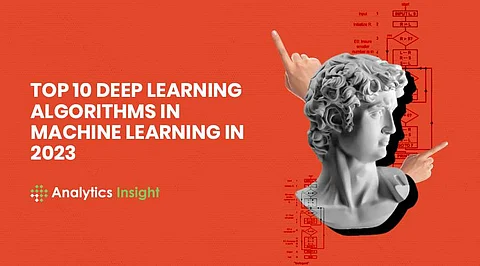

Deep learning has become extremely popular in scientific computing, and businesses that deal with complicated issues frequently employ its techniques. To carry out particular tasks, all deep learning algorithms employ various kinds of neural networks. To simulate the human brain, this article looks at key artificial neural networks and how deep learning algorithms operate.
Artificial neural networks are used in deep learning to carry out complex calculations on vast volumes of data. It is a form of artificial intelligence that is based on how the human brain is organized and functions. Deep learning methods are used to train machines by teaching them from examples. Deep learning is frequently used in sectors like healthcare, eCommerce, entertainment, and advertising. Here are the top 10 deep learning algorithms you should be aware of in 2023.
To handle complex problems, deep learning algorithms need a lot of processing power and data. They can operate with nearly any type of data. Let's now take a closer look at the top 10 deep learning algorithms to be aware of in 2023.
CNNs, also known as ConvNets, have multiple layers and are mostly used for object detection and image processing. Yann LeCun built the original CNN in 1988, while it was still known as LeNet. It was used to recognize characters like ZIP codes and numerals. CNNs are used in the identification of satellite photographs, the processing of medical imaging, the forecasting of time series, and the detection of anomalies.
DBNs are generative models made up of several layers of latent, stochastic variables. Latent variables, often called hidden units, are characterized by binary values. Each RBM layer in a DBN can communicate with both the layer above it and the layer below it because there are connections between the layers of a stack of Boltzmann machines. For image, video, and motion-capture data recognition, Deep Belief Networks (DBNs) are employed.
The outputs from the LSTM can be sent as inputs to the current phase thanks to RNNs' connections that form directed cycles. Due to its internal memory, the LSTM's output can remember prior inputs and is used as an input in the current phase. Natural language processing, time series analysis, handwriting recognition, and machine translation are all common applications for RNNs.
Deep learning generative algorithms called GANs produce new data instances that mimic the training data. GAN is made up of two components: a generator that learns to generate fake data and a discriminator that incorporates the false data into its learning process.
Over time, GANs have become more often used. They can be used in dark-matter studies to simulate gravitational lensing and improve astronomy images. Video game developers utilize GANs to reproduce low-resolution, 2D textures from vintage games in 4K or higher resolutions by employing image training.
Recurrent neural networks (RNNs) with LSTMs can learn and remember long-term dependencies. The default behavior is to recall past knowledge for extended periods.
Over time, LSTMs preserve information. Due to their ability to recall prior inputs, they are helpful in time-series prediction. In LSTMs, four interacting layers connect in a chain-like structure to communicate especially. LSTMs are frequently employed for voice recognition, music creation, and drug research in addition to time-series predictions.
Radial basis functions are a unique class of feedforward neural networks (RBFNs) that are used as activation functions. They typically have an input layer, a hidden layer, and an output layer and are used for classification, regression, and time-series prediction.
SOMs, created by Professor Teuvo Kohonen, provide data visualization by using self-organizing artificial neural networks to condense the dimensions of the data. Data visualization makes an effort to address the issue that high-dimensional data is difficult for humans to see. SOMs are developed to aid people in comprehending this highly dimensional data.
RBMs are neural networks that can learn from a probability distribution across a collection of inputs; they were created by Geoffrey Hinton. classification, Dimensionality reduction, regression, feature learning, collaborative filtering, and topic modeling are all performed with this deep learning technique. The fundamental units of DBNs are RBMs.
A particular kind of feedforward neural network called an autoencoder has identical input and output. Autoencoders were created by Geoffrey Hinton in the 1980s to address issues with unsupervised learning. The data is replicated from the input layer to the output layer by these trained neural networks. Image processing, popularity forecasting, and drug development are just a few applications for autoencoders.
MLPs are a type of feedforward neural network made up of multiple layers of perceptrons with activation functions. A completely coupled input layer and an output layer make up MLPs. They can be used to create speech recognition, picture recognition, and machine translation software since they have the same number of input and output layers but may have several hidden layers.
Join our WhatsApp Channel to get the latest news, exclusives and videos on WhatsApp
_____________
Disclaimer: Analytics Insight does not provide financial advice or guidance. Also note that the cryptocurrencies mentioned/listed on the website could potentially be scams, i.e. designed to induce you to invest financial resources that may be lost forever and not be recoverable once investments are made. You are responsible for conducting your own research (DYOR) before making any investments. Read more here.
